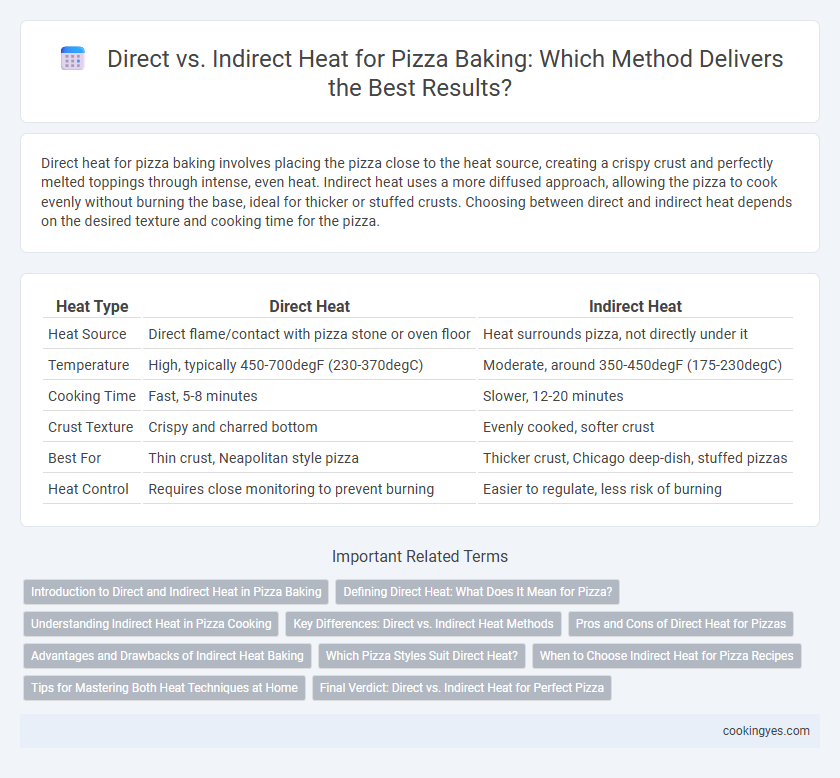Direct heat for pizza baking involves placing the pizza close to the heat source, creating a crispy crust and perfectly melted toppings through intense, even heat. Indirect heat uses a more diffused approach, allowing the pizza to cook evenly without burning the base, ideal for thicker or stuffed crusts. Choosing between direct and indirect heat depends on the desired texture and cooking time for the pizza.
Table of Comparison
| Heat Type | Direct Heat | Indirect Heat |
|---|---|---|
| Heat Source | Direct flame/contact with pizza stone or oven floor | Heat surrounds pizza, not directly under it |
| Temperature | High, typically 450-700degF (230-370degC) | Moderate, around 350-450degF (175-230degC) |
| Cooking Time | Fast, 5-8 minutes | Slower, 12-20 minutes |
| Crust Texture | Crispy and charred bottom | Evenly cooked, softer crust |
| Best For | Thin crust, Neapolitan style pizza | Thicker crust, Chicago deep-dish, stuffed pizzas |
| Heat Control | Requires close monitoring to prevent burning | Easier to regulate, less risk of burning |
Introduction to Direct and Indirect Heat in Pizza Baking
Direct heat in pizza baking involves placing the dough close to the heat source, typically a wood-fired oven or grill, which produces a crispy crust and quick cooking time. Indirect heat uses convection or radiant heat by positioning the pizza away from the flame, resulting in more even cooking and preventing burning, ideal for thicker crusts or toppings needing gentle melting. Mastering the balance between direct and indirect heat optimizes texture, flavor, and cooking efficiency in artisanal pizza making.
Defining Direct Heat: What Does It Mean for Pizza?
Direct heat for pizza baking involves placing the pizza close to the heat source, such as in a wood-fired oven, where intense heat rapidly cooks the crust and toppings, creating a crispy exterior and bubbly cheese. This method concentrates temperatures typically between 600degF to 900degF, allowing for quick cooking times of 90 seconds to 3 minutes, essential for Neapolitan-style pizzas. Direct heat enhances caramelization and charring, delivering flavors and textures distinct from indirect heat methods.
Understanding Indirect Heat in Pizza Cooking
Indirect heat in pizza cooking involves placing the pizza away from direct flames or heat sources, allowing for a slower and more even bake that prevents burning the crust while thoroughly melting toppings. This method uses convection to circulate warm air around the pizza, resulting in a crisp crust and evenly cooked ingredients without excessive charring. Understanding indirect heat is essential for achieving balanced texture and flavor, especially when using wood-fired ovens or grills where precise temperature control is critical.
Key Differences: Direct vs. Indirect Heat Methods
Direct heat baking exposes pizza dough directly to the heat source, producing a crispy crust with charred spots and a quick cook time, ideal for thin crust styles. Indirect heat uses radiant heat from walls or surrounding air, promoting even cooking and preventing burnt bottoms, suitable for thicker, chewier crusts. Key differences lie in heat intensity, cooking speed, and crust texture outcomes between direct flame contact and heat circulation approaches.
Pros and Cons of Direct Heat for Pizzas
Direct heat for pizza baking involves placing the pizza close to the heat source, such as a wood-fired oven or grill, resulting in a crispy crust and well-caramelized toppings. This method provides rapid cooking, preserving moisture and enhancing flavors but risks burning the crust if not monitored carefully. Direct heat is ideal for Neapolitan-style pizzas requiring high temperatures around 800-900degF, offering quick cook times of 60-90 seconds and a distinctive charred texture.
Advantages and Drawbacks of Indirect Heat Baking
Indirect heat baking for pizza offers the advantage of even cooking and prevents the crust from burning, producing a tender interior with a crispy exterior. This method allows better control over temperature, reducing the risk of overcooking toppings while achieving thorough dough fermentation. However, indirect heat can result in longer cooking times and may lack the intense char and smoky flavor characteristic of direct flame baking.
Which Pizza Styles Suit Direct Heat?
Neapolitan and New York-style pizzas excel with direct heat due to their thin crusts and quick cooking times, allowing the high temperature to create a crisp exterior while maintaining a soft interior. Direct heat from wood-fired or gas ovens ensures rapid baking, producing characteristic leopard spotting and a chewy texture. Conversely, thicker crust styles like Sicilian or deep-dish benefit from indirect heat to cook evenly without burning.
When to Choose Indirect Heat for Pizza Recipes
Indirect heat for pizza baking is ideal when using thicker crusts or loaded with numerous toppings that require longer cooking without burning. This method allows even heat distribution, preventing the crust from charring while ensuring toppings cook thoroughly. Choosing indirect heat is essential for recipes involving deep-dish or stuffed crust pizzas where slower heat treatment enhances texture and flavor.
Tips for Mastering Both Heat Techniques at Home
Using direct heat for pizza baking creates a crispy crust by exposing dough to intense, focused heat, ideal for stone or grill cooking methods. Indirect heat offers a gentler cooking environment, allowing toppings to cook evenly without burning, perfect for thicker pizzas or ovens with heat zones. Master this balance by preheating pizza stones for direct heat and positioning pizzas away from flames for indirect heat, ensuring a perfectly baked crust and well-melted toppings.
Final Verdict: Direct vs. Indirect Heat for Perfect Pizza
Direct heat exposure produces a crisp, charred crust essential for traditional Neapolitan pizzas, while indirect heat ensures even cooking and a softer, well-risen dough ideal for thicker styles like Sicilian. Professional pizzaiolos often prefer direct heat at temperatures above 900degF to achieve the perfect leopard spotting on the crust, whereas indirect heat around 400-500degF works best for slow baking and maintaining moisture. For home ovens, a combination method--starting with direct heat to crisp the base, then finishing with indirect heat--delivers balanced texture and flavor, making it the optimal approach for perfect pizza.
Direct vs Indirect for pizza baking heat Infographic

 cookingyes.com
cookingyes.com